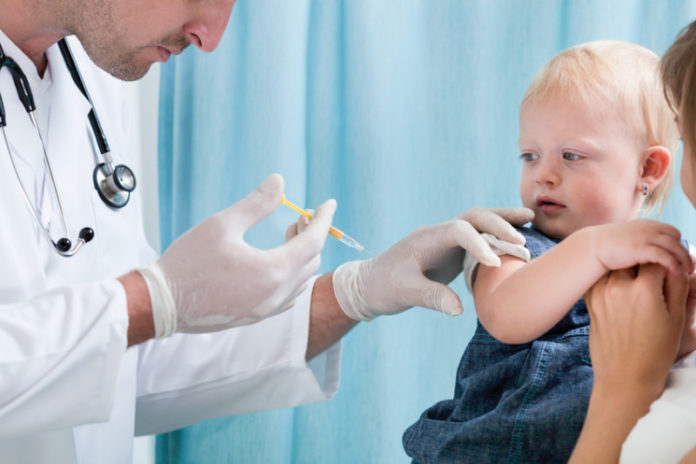
Infants show distinct, consistent patterns of brain activity in response to painful vaccinations, reports a study in the February issue of PAIN®, the official publication of the International Association for the Study of Pain.
“We have shown that inoculation evokes, from the time of the first needle contact, a clearly defined EEG response in infants up to at least one year of age,” write Dr Madeleine Verriotis and colleagues of University College London. They believe this “brain-led approach” to assessing procedure-related pain in infants may help in developing improved vaccination techniques and pain-relieving treatments.
Brain Activity in Response to Shots in Infants…
The researchers performed elecroencephalography (EEG) in 15 healthy babies receiving routine vaccinations. A noninvasive and painless procedure, EEG is done to measure electrical activity in the brain, using electrodes placed in specific locations on the scalp. Twelve infants were tested during vaccinations at age one to two months, and five at age 12 months.
Dr Verriotis and colleagues compared the EEG findings with behavioral pain responses: facial expression, crying, and movements. Such behavioral responses are the standard method for assessing pain in preverbal infants. The researchers filmed the procedures to identify the precise timing of EEG responses to vaccination pain.
The EEG recordings showed two clear waveforms, or “spikes,” which appeared within milliseconds after the first contact of the needle with the infant’s skin. Although the waveforms appeared in both age groups, they were significantly larger in one- to two-month-old infants than in one-year-olds.
In three infants studied at both ages, the EEG responses–particularly for the first waveform–appeared clearer and larger at age 12 months. The EEG patterns were also more reproducible in older infants. The researchers suggest that these age-related differences might reflect developmental changes in the brain during the first year of life: an increased number of neurons (nerve cells), a larger proportion of neurons being activated, or better synchronization of firing activity.
…But No Relation between EEG and Behavioral Pain Responses
Of course, infants of both ages showed strong and immediate behavioral responses to the vaccinations. However, there was no direct association between differences in the EEG waveforms and differences in the behavioral pain responses.
This may have at least partly reflected the fact that behavioral pain responses were close to maximal (8 on a 10-point scale) in most infants. Dr Verriotis and coauthors write, “Cortical EEG activity…shows that the noxious stimulus is being processed in the brain, with some individual variability, but is not necessarily a direct read-out of the amount of pain perceived.”
Vaccinations are the most common cause of procedural pain in children. Although it may seem harmless, pain from frequent vaccinations is a source of anxiety and distress for the child, and a concern to parents as well as healthcare providers. “There is emerging evidence that fear of needles in both parents and children affects medical care,” the researchers note. Improved pain management during routine vaccinations is therefore an important goal.
The new study, by showing a “clearly defined EEG response” to shots in infants up to one year of age “may provide a quantitative measure of cortical pain activity that could be used to investigate the efficacy of pain relieving interventions,” Dr Verriotis and colleagues conclude. They add that future studies tracking pain responses over time may help in understanding the long-term development of pain processing in the infant brain.
Story Source:
The above story is based on materials provided by Wolters Kluwer Health: Lippincott Williams and Wilkins. Note: Materials may be edited for content and length.
Journal Reference:
- Madeleine Verriotis, Lorenzo Fabrizi, Amy Lee, Sheryl Ledwidge, Judith Meek, Maria Fitzgerald. Cortical activity evoked by inoculation needle prick in infants up to one-year old. PAIN, 2015; 156 (2): 222 DOI: 10.1097/01.j.pain.0000460302.56325.0c
